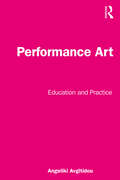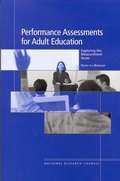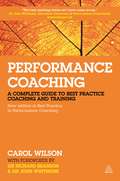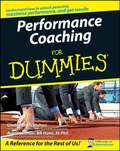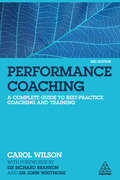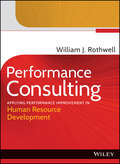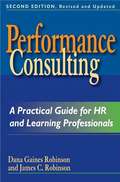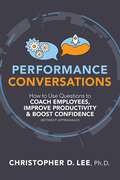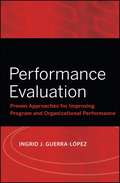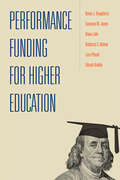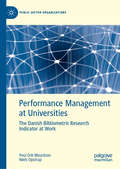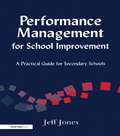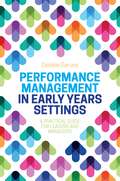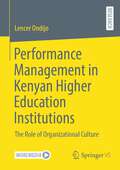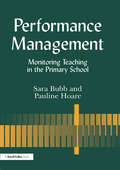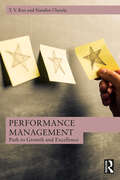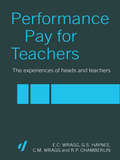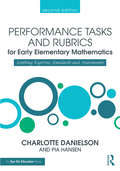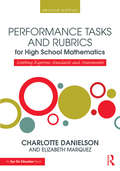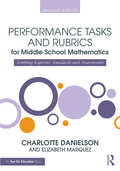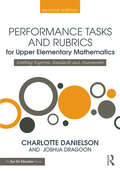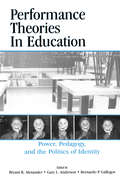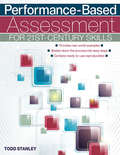- Table View
- List View
Performance Art: Education and Practice
by Angeliki AvgitidouPerformance Art: Education and Practice is an introduction to performance art through activities and practice prompts that are framed by seminal moments in the history of the medium as well as the current theoretical discussions surrounding performance. The book begins by introducing the terminology related to performance art and its early history. The basic elements of performance, including the body, objects, space, the public, and the public sphere are approached through thematic and conceptual correlations such as objects as autobiography, body as an expression of gendered identity, performance and the everyday, the augmented body, the archive of performance, and public space as space for intervention. Case studies analysed in each chapter are accompanied by reflective questions and discussion topics. The book proposes a wide range of exercises and comprehensive practice prompts that aim to enhance performance skills, promote experimentation, and encourage an experiential understanding of the theory, history, and concepts relating to performance art. Performance Art: Education and Practice is addressed to students of Fine Arts and Performance Studies from beginner to intermediate level, performance and visual artists who are interested in expanding their knowledge base and creative range, and artist-teachers who are interested in developing their own curriculum and workshop content.
Performance Assessments for Adult Education: Exploring the Measurement Issues
by Committee for the Workshop on Alternatives for Assessing Adult Education Literacy ProgramsA report on Performance Assessments for Adult Education
Performance Coaching
by Carol WilsonEffective performance coaching helps individuals and organizations achieve their maximum potential, tackle challenges, and reach specific goals. It leads to personal and professional development and helps create a work-life balance. Written as an introduction for those thinking of becoming or hiring a coach – personal or corporate – and a reference guide for experienced coaches, Performance Coaching offers a guide to the fundamentals of coaching by illustrating how to develop a best practice approach Using practical tools throughout the text and international case studies to demonstrate the various cultural challenges, Performance Coaching is a complete resource for developing coaching in any organization. The new edition is completely updated to offer a greater focus on building a coaching culture in organizations and on the challenges that leaders face in understanding and developing a coaching approach.
Performance Coaching For Dummies
by Gladeana Mcmahon Averil LeimonPerformance coaching is a modern and rapidly growing method used to assist development, and involves helping individuals to improve their performance in all areas of their life, with a particular emphasis on the workplace. Performance coaching draws parallels with NLP and often focuses on the psychology of excellence - making what's good even better, and helping individuals keep ahead of the game. On an organisational level it can include helping managers to consider how to get the best from their staff, peers and superiors, as well as helping to identify strengths, weaknesses, opportunities and threats. A performance coach assists individuals in building on their successes and helps to design, plan and instigate successful business/life strategies.Despite its popularity confusion still surrounds coaching. It is a relatively new area and there is still a lack of understanding about how best to use coaching and in what specific situations it will be most effective. In addition to this, anyone can assume a performance/professional/business/life coach title without holding any particular qualification or registration. With this increased awareness and confusion the need for a no-nonsense book on the topic that offers trusted advice is needed all the more, which is where Performance Coaching For Dummies steps in.
Performance Coaching: A Complete Guide to Best Practice Coaching and Training
by Carol WilsonPerformance Coaching is a complete resource for improving organizational and employee performance through coaching. Full of tips, tools and checklists, it covers all the fundamental elements of the coaching process, from developing the skills needed to coach effectively, to coaching in leadership, cross-cultural coaching and measuring return on investment. It also explores the key techniques and models in the field, from 360-degree feedback to Neuro-linguistic programming (NLP), to allow readers to identify which approach is most suited to specific situations. Featuring case studies from organizations including Virgin, Johnson & Johnson and IKEA showing how effective coaching approaches have been applied in practice, this book is for coaches of all levels of experience, as well as HR managers and leaders looking to embed a coaching culture in their organizations.This revised third edition of Performance Coaching has been updated to include the latest insights and developments and contains new chapters on distance coach training and peer leadership in the workplace and new material on neuroscience in coaching, coaching in education, managing difficult conversations and stakeholder mapping.
Performance Consulting
by William J. RothwellImproving individual and organizational performance is imperative to establishing and maintaining a high performance workplace, developing intellectual capital, promoting productivity, and enhancing profitability. Organizations must be flexible and agile in approaching business strategies. Against this backdrop, the time has come to revisit the role of training, HRD, and instructional design in today's organizations. Performance Consulting: Applying Performance Improvement in Human Resource Development is a leading-edge text that maps to existing curricula and syllabi, as well as real-world workplace learning and performance workflow, covering HRD, systemic and strategic approaches to organizational learning and performance improvement, roles, competencies, instructional design, performance analysis and evaluation, and implementation.
Performance Consulting: A Practical Guide for HR and Learning Professionals (2nd edition)
by Dana Gaines Robinson James C. RobinsonThis work helps readers master the science and art of performance consulting, looking at analytical and assessment techniques as well as consultative and partnering practices. This second edition covers dozens of new tools and techniques, with numerous templates, checklists, and graphics available on the publisher's web site. There is a new chapter on how to proactively identify performance consulting opportunities. Another new chapter answers questions the authors have been asked frequently in the years since the first edition was published. Exercises, key points, and a glossary are included, along with real-life examples of people who have put the techniques described in the book into practice. The readership for the book includes professionals in training, human resources, and organizational development. The authors are consultants. Annotation ©2008 Book News, Inc., Portland, OR (booknews.com)
Performance Conversations: How to Use Questions to Coach Employees, Improve Productivity, and Boost Confidence (Without Appraisals!)
by Christopher D. LeeThere are three universal truths about traditional performance management: they are widely used, universally despised, and are known to be ineffective. Performance Conversations offers a new model rooted in proven management science and tailored to today's workplace. Moving beyond ad hoc alternatives, this approach provides a unified framework for enhancing employee performance through continuous, manager-led practices. Like sliding the right key in a lock, performance conversations can open the door to unlimited possibilities. Dozens of ready-to-use templates and tools make the system practical, accessible, and easy to implement. Designed with today's workforce in mind, it aligns with the expectations of millennial and remote employees alike.Perfect for HR leaders and team managers, this guide delivers a smart, actionable solution for improving performance without the frustration of traditional reviews.
Performance Evaluation: Proven Approaches for Improving Program and Organizational Performance
by Ingrid J. Guerra-LópezPerformance Evaluation is a hands-on text for practitioners, researchers, educators, and students in how to use scientifically-based evaluations that are both rigorous and flexible. Author Ingrid Guerra-López, an internationally-known evaluation expert, introduces the foundations of evaluation and presents the most applicable models for the performance improvement field. Her book offers a wide variety of tools and techniques that have proven successful and is organized to illustrate evaluation in the context of continual performance improvement.
Performance Funding for Higher Education
by Vikash Reddy Kevin J. Dougherty Rebecca S. Natow Sosanya M. Jones Hana Lahr Lara PheattA rigorous analysis of the impact—and implications—of performance funding for higher education.Seeking greater accountability in higher education, many states have adopted performance funding, tying state financial support of colleges and universities directly to institutional performance based on specific outcomes such as student retention, progression, and graduation. Now in place in over thirty states, performance funding for higher education has been endorsed by the US Department of Education and major funders like the Gates and Lumina foundations. Focusing on three states that are regarded as leaders in the movement—Indiana, Ohio, and Tennessee—Performance Funding for Higher Education presents the findings of a three-year research study on its implementation and impacts. Written by leading authorities and drawing on extensive interviews with government officials and college and university staff members, this book describes the policy instruments states use to implement performance funding; explores the organizational processes colleges rely on to determine how to respond to performance funding; analyzes the influence of performance funding on institutional policies and programs; reviews the impacts of performance funding on student outcomes; examines the obstacles institutions encounter in responding to performance funding demands; investigates the unintended impacts of performance funding. The authors conclude that, while performance funding clearly grabs the attention of colleges and leads them to change their policies and practices, it also encounters major obstacles and has unintended impacts. Colleges subject to performance funding are hindered in posting good results by inappropriate performance measures, insufficient organizational infrastructure, and the commitment to enroll many students who are poorly prepared or not interested in degrees. These obstacles help explain why multivariate statistical studies have failed to date to find a significant impact of performance funding on student outcomes, and why colleges are tempted to resort to weakening academic quality and restricting the admission of less-prepared and less-advantaged students in order to improve their apparent performance. These findings have wide-ranging implications for policy and research. Ultimately, the authors recommend that states create new ways of helping colleges with many at-risk students, define performance indicators and measures better tailored to institutional missions, and improve the capacity of colleges to engage in organizational learning.
Performance Management
by University Of MadrasPerformance management has assumed a pivotal role in the face of rapid changes such as globalization, liberalization, technological and market changes, it is the backbone of human resource management for any organization intending to produce a high performance and leverage its human capital. Human resource management during the last two decades has shifted its focus from maintenance and administrative kind of function to that of a value added role. In this process, performance management has occupied a centre stage. In other words, all people management efforts are directed towards enhancing performance of employees and thereby improving the bottom line of organizations.
Performance Management at Universities: The Danish Bibliometric Research Indicator at Work (Public Sector Organizations)
by Poul Erik Mouritzen Niels Opstrup"Mouritzen and Opstrup's book is a most welcome addition to the subject of the management of academic performance. It is certainly well-worth reading and considering."—Bruno S. Frey, Permanent Visiting Professor at the University of Basel and Research Director CREMA - Center for Research in Economics, Management and the Arts, Switzerland"This superb book should be read by anyone interested higher education evaluation as well as by those who are subjected to it."—Barry Bozeman, Regents' Professor, Arizona Centennial Professor of Technology Policy and Public Management, School of Public Affairs, Arizona State University, USA"In Performance Management at Universities, Mouritzen and Opstrup definitively answer the question: What are the effects of national university performance-based funding schemes that use bibliometric indicators? The authors marshal comprehensive data on the Danish university system to sift through the many predictions commonly made by academics newly subject to these systems to identify what actually happened to Danish research as the system took hold."—Diana Hicks, Professor, School of Public Policy, Georgia Institute of Technology, USA, and first author on the Leiden Manifesto on research metricsThis book gives an account of what can happen when performance management is introduced at universities. How do scholars – for better or worse – respond to a system which counts the number of articles and books? Many myths exist about scholar’s reactions: They cheat, slice their production to the least publishable unit, become more risk averse and will go for the low-hanging fruits; in short, they develop a “taste for publication” at the cost of a “taste of science”. Systematic knowledge about the consequences of such systems for the motivation, behavior and productivity of university scholars is in short supply. The book is a major contribution to remedy this situation.
Performance Management for School Improvement: A Practical Guide for Secondary Schools
by Jeff JonesThe recently introduced Performance Management (PM) arrangements for headteachers and teachers will replace the existing appraisal systems for schools in England. The introduction of PM places a significant responsibility upon governors strategically, and upon senior and middle managers operationally.This is a manual for middle managers and head teachers in secondary schools. It offers support and guidance on the new performance management legislation, the practical issues surrounding its introduction and strategies for successful implementation.The book will include sections on how to integrate PM into the school's other management processes, what roles and responsibilities need to be carried out, and managing the performance of teachers and headteachers. It will also cover the appraisal cycle, setting objectives, classroom observation, and selecting and appointing team leaders. The book also discussed auditing, monitoring, evaluating and reporting.
Performance Management in Early Years Settings: A Practical Guide for Leaders and Managers
by Debbie GarveyIn this accessible and informative step-by-step guide, early years consultant Debbie Garvey provides leaders and managers with best practice tips and advice for developing their performance management skills in early years settings. Drawing on current research and the author's wealth of experience in the field, each chapter sets out effective performance management techniques that leaders can apply to their workplaces, on topics such as staff development, recruitment, appraisals, conflict management, feedback and evaluation, mentoring and coaching and health and wellbeing. Grounded in an understanding of neuroscience and brain development, this practical book provides advice on how to ensure a safe and motivational environment for both children and staff to develop, whatever their needs. Designed to support new and existing managers, the book includes reflective exercises, key theories and case studies to enable leaders to develop a style suited to their team and setting, ensuring children are given the best possible support during their first and most crucial development stage.
Performance Management in Kenyan Higher Education Institutions: The Role of Organizational Culture
by Lencer OndijoThe present study exploratively investigated the role of organizational culture in performance management practices in Kenyan higher education institutions. Specifically, the influence of organizational culture on the purpose and extent to which performance information is used was explored. Qualitative interviews were conducted followed by quantitative surveys, which were filled out by teaching and non-teaching staff in various universities in Kenya. The findings provide evidence of linkages between performance information use, diversity of measure and organizational culture. It has been established that, depending on whether flexibility or control values are dominant in the culture of an institution; performance information is used in varying ways. Institutions where flexibility values were dominant in their organizational cultures used performance information for attention focus, monitoring and decision making to a higher extent than universities where control values were dominant. Institutions where Flexibility values were dominant also showed a more diverse set of performance measures than in those where control values were dominant.
Performance Management: Monitoring Teaching in the Primary School
by Sara Bubb Pauline HoareThis research-based book offers practical guidance on how to go about performance management. Based on experience of working with schools and running courses, and using the latest research on business strategies appropriate for education, it: o looks at what performance management means in practice o offers advice on how to go about monitoring o explains how to use data from pupil assessments o suggests ways to judge the effectiveness of teaching through analysing children's work o gives guidance on monitoring planning, assessment and observing lessons o proposes how to 1853467693reas for development, set objectives and draw up action plans o contains useful photocopiable formats o uses case study material to illustrate potential problems and good practice Throughout, the purpose is to help schools and teachers to be more effective.
Performance Management: Path to Growth and Excellence
by T. V. Rao Nandini ChawlaThis book attempts to shift focus from performance appraisals to performance management incorporating performance planning, analysis, and development as critical components of it. The performance management system (PMS) is a future-driven exercise rather than merely a past-reviewing exercise. Performance management is treated as a year-round practice and not an appraisal process conducted once a quarter or annually. Moreover, it is now considered to be everyone’s responsibility and not merely that of HR or the upper management.This book advocates the structuring of PMSs and their implementation. It incorporates the most modern 360-degree feedback systems and shows the ways and means of integrating it into PMS. Arguments are offered to use rating-less appraisals and/or a combination of appraisals with 360-degree feedback. It defines performance management to mean continuous improvements in performance of individuals, their teams, departments, and corporations. It also outlines that planning, analysis, review, coaching, and capability building are essential building blocks for good performance management.Concise, lucid, and engaging, this volume would be useful to the students, researchers, and faculty of human resource management, organizational behaviour and applied psychology. It would also be an invaluable guidebook for practicing business executives and HR professionals to help them implement the performance management system for effective talent management leading to increased productivity.
Performance Pay for Teachers: The Views And Experiences Of Heads And Teachers
by C. M. Wragg G. S. Haynes R. P. ChamberlinThe first widespread incentive pay scheme was initiated in UK schools in 2000. This book is the result of monitoring the whole process from its inception. The authors visited schools, observed lessons, and solicited the views and experiences of a large collection of teachers and headteachers. Their discoveries are presented in this lively book. They include the views of teachers who were successful in crossing the threshold, those who weren't and those who chose not to apply, and headteachers who had to make the decisions. The book focuses on the following schemes: * headteachers' experiences of training* the outcomes in their own school* their relationship with external assessors* their hopes and fears for the future* their assessment of the influence on classroom practice* what did teachers change and not change in their teaching as a result of performance management* what means they employed to further their own professional development. This timely book is a useful resource for anyone involved in education, whether it be a classroom teacher, headteacher, administrator or policy-maker.
Performance Reviews and Coaching: The Performance Management Collection (5 Books)
by Harvard Business Review Dick GroteIf you're an executive, manager, or team leader, one of your toughest responsibilities is managing your people's performance. This digital collection, curated by Harvard Business Review, will help you evaluate employee performance, provide coaching, conduct performance reviews, give effective feedback, and more; it includes Dick Grote's How to be Good at Performance Appraisals; Harvard Business Essentials' Performance Management; the HBR Guide to Coaching Employees; and Giving Effective Feedback and Performance Reviews, both from HBR's 20-Minute Manager Series.
Performance Tasks and Rubrics for Early Elementary Mathematics: Meeting Rigorous Standards and Assessments (Math Performance Tasks)
by Pia HansenPerformance tasks are highly effective tools to assist you in implementing rigorous standards. But how do you create, evaluate, and use such tools? In this bestselling book, educational experts Charlotte Danielson and Pia Hansen explain how to construct and apply performance tasks to gauge students’ deeper understanding of mathematical concepts at the early elementary level. You’ll learn how to: Evaluate the quality of performance tasks, whether you’ve written them yourself or found them online; Use performance tasks for instructional decision-making and to prepare students for summative assessments; Create your own performance tasks, or adapt pre-made tasks to best suit students’ needs; Design and use scoring rubrics to evaluate complex performance tasks; Use your students’ results to communicate more effectively with parents. This must-have second edition is fully aligned to the Common Core State Standards and assessments and includes a variety of new performance tasks and rubrics, along with samples of student work. Additionally, downloadable student handout versions of all the performance tasks are available as free eResources from our website (www.routledge.com/97811389069891), so you can easily distribute them to your class.
Performance Tasks and Rubrics for High School Mathematics: Meeting Rigorous Standards and Assessments (Math Performance Tasks)
by Elizabeth Marquez Charlotte DanielsonPerformance tasks are highly effective tools to assist you in implementing rigorous standards. But how do you create, evaluate, and use such tools? In this bestselling book, educational experts Charlotte Danielson and Elizabeth Marquez explain how to construct and apply performance tasks to gauge students’ deeper understanding of mathematical concepts at the high school level. You’ll learn how to: Evaluate the quality of performance tasks, whether you’ve written them yourself or found them online; Use performance tasks for instructional decision-making and to prepare students for summative assessments; Create your own performance tasks, or adapt pre-made tasks to best suit students’ needs; Design and use scoring rubrics to evaluate complex performance tasks; Use your students’ results to communicate more effectively with parents. This must-have second edition is fully aligned to the Common Core State Standards and assessments and includes a variety of new performance tasks and rubrics, along with samples of student work. Additionally, downloadable student handout versions of all the performance tasks are available as free eResources from our website (www.routledge.com/9781138906990), so you can easily distribute them to your class.
Performance Tasks and Rubrics for Middle School Mathematics: Meeting Rigorous Standards and Assessments (Math Performance Tasks)
by Elizabeth Marquez Charlotte DanielsonPerformance tasks are highly effective tools to assist you in implementing rigorous standards. But how do you create, evaluate, and use such tools? In this bestselling book, educational experts Charlotte Danielson and Elizabeth Marquez explain how to construct and apply performance tasks to gauge students’ deeper understanding of mathematical concepts at the middle school level. You’ll learn how to: Evaluate the quality of performance tasks, whether you’ve written them yourself or found them online; Use performance tasks for instructional decision-making and to prepare students for summative assessments; Create your own performance tasks, or adapt pre-made tasks to best suit students’ needs; Design and use scoring rubrics to evaluate complex performance tasks; Use your students’ results to communicate more effectively with parents. This must-have second edition is fully aligned to the Common Core State Standards and assessments and includes a variety of new performance tasks and rubrics, along with samples of student work. Additionally, downloadable student handout versions of all the performance tasks are available as free eResources from our website (www.routledge.com/9781138906914), so you can easily distribute them to your class.
Performance Tasks and Rubrics for Upper Elementary Mathematics: Meeting Rigorous Standards and Assessments (Math Performance Tasks Ser.)
by Charlotte Danielson Joshua DragoonPerformance tasks are highly effective tools to assist you in implementing rigorous standards. But how do you create, evaluate, and use such tools? In this bestselling book, educational experts Charlotte Danielson and Joshua Dragoon explain how to construct and apply performance tasks to gauge students’ deeper understanding of mathematical concepts at the upper elementary level. You’ll learn how to: Evaluate the quality of performance tasks, whether you’ve written them yourself or found them online; Use performance tasks for instructional decision-making and to prepare students for summative assessments; Create your own performance tasks, or adapt pre-made tasks to best suit students’ needs; Design and use scoring rubrics to evaluate complex performance tasks; Use your students’ results to communicate more effectively with parents. This must-have second edition is fully aligned to the Common Core State Standards and assessments and includes a variety of new performance tasks and rubrics, along with samples of student work. Additionally, downloadable student handout versions of all the performance tasks are available as free eResources from our website (www.routledge.com/9781138906969), so you can easily distribute them to your class.
Performance Theories in Education: Power, Pedagogy, and the Politics of Identity
by Gary L. Anderson Bernardo P. Gallegos Bryant K. AlexanderPerformance Theories in Education: Power, Pedagogy, and the Politics of Identity breaks new ground by presenting a range of approaches to understanding the role, function, impact, and presence of performance in education. It is a definitive contribution to a beginning dialogue on how performance, as a theoretical and pragmatic lens, can be used to view the processes, procedures, and politics of education. The conceptual framework of the volume is the editors' argument that performance and performativity help to locate and describe repetitive actions plotted within grids of power relationships and social norms that comprise the context of education and schooling. The book brings together performance studies and education researchers, teachers, and scholars to investigate such topics as: *the relationship between performance and performativity in pedagogical practice; *the nature and impact of performing identities in varying contexts; *cultural and community configurations that fall under the umbrella of teaching, education, and schooling; and *the hot button issues of educational policies and reform as performances. With the aim of developing a clearer understanding of the effect, affect, and role of performance in education, the volume provides a crucial starting point for discourse among theorists and teacher practitioners who are interested in understanding and acknowledging the politics of performance and the practices of performative social identities that always and already intervene in the educational endeavor.
Performance-Based Assessment for 21st-Century Skills
by Todd StanleyPerformance-based assessments allow classroom teachers an alternative to traditional multiple-choice tests. We often use fill-in-the bubble assessments in education to determine the readiness of students. However, in the 21st-century workplace, these types of tests fail to truly prepare students. How many times in the real world are we called upon to take a multiple-choice test? In the real world, we are called upon to prove our merit through performance-based assessments, displaying our 21st-century skills. We should be preparing students for this in the classroom. Performance-Based Assessment for 21st-Century Skills makes the argument that teachers should use performance-based assessments in the classroom. It guides the educator step by step to show how he or she can create performance-based assessments for students, including what they look like, teaching students how to create them, setting the proper classroom environment, and how to evaluate them.
